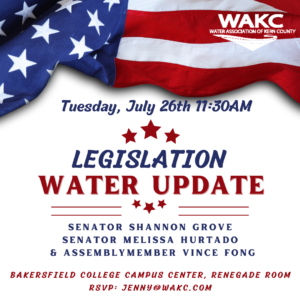The Tri County Water Authority held a Thursday, July 21, 2022 special meeting of its board of directors on Zoom at its Corcoran headquarters. Like many districts in the San Joaquin Valley Tri County is tied hip and jowl with a Groundwater Sustainability Agency. The deadlines for submitting retooled Groundwater Sustainability Plans are no longer over the horizon but quickly approaching. The agenda indicates Tri County will be dealing with this issue as well as setting itself up for funding.
horizon but quickly approaching. The agenda indicates Tri County will be dealing with this issue as well as setting itself up for funding.
Before we start the Tri County meeting I want to point out the Public Policy Institute of California is cranking out more reports. Go to https://www.ppic.org/ to take a gander at the just released report Exploring the Potential for Water-Limited Agriculture in the San Joaquin Valley. There is also the Land Transitions & Dust in the San Joaquin Valley report and on July 26th at 11:00am there will be a webinar to discuss some of the ideas behind this look at possible transitions of land use. What I appreciate about this webinar besides it being only an hour and 15-minutes long is there are actual farmers from the Valley on the panel.
The Meeting
The Tri County meeting kicked in at 10:00am and without skipping a beat they swore in Mike Nordstrom as the newest director. Chairman Cory VanderHam had attorney Jason Howard swear Nordstrom in with the vow to defend the Constitution from enemies from within and without. Good for him. There was no public comment and the consent calendar was passed.
Action items
There were a number of resolutions before the board. Tri County does business in both Kings and Tulare Counties and each requires separate resolutions to achieve the same results. The first resolution was approving levying of 2023 assessments. This passed and required resolutions for the two counties.
Resolution 22-06 will levy a 2023 pumping fee at $10 per a/f as long as the amount pumped remains within the sustainable range. The board passed the resolution and that I believe ended the financial resolutions.
GSP
Executive Director Deanna Jackson reminded the board DWR found the GSP’s water levels, subsidence and water quality portions were lacking. Engineer Amer Hussain explained the path taken to get the GSP into compliance. At least it’s hoped it will be found as compliant.
Hussain said the first issue was to set the minimum water level at 50 feet above the Corcoran clay layer in the confined portions of the aquifer. Subsidence is mostly a concern along the California Aqueduct. He explained protecting infrastructure will be ensured by an early warning monitoring system with actions to be triggered.
Hussain was asked about subsidence’s impact on local infrastructure and what can be done. He said that concern is being addressed. There will be some displacement, everyone knows that will happen but the glidepath to get time to adjust is in place. He was also asked about the range of the clay layer depth. It’s from 300 to 700 feet. There are a series of monitoring wells with more having been added in the GSP revision. He said he’d like to see more wells added as time goes by.
Water quality was addressed by listing all the constituents of concern and a water sampling protocol to keep up with both domestic and ag standards. There are naturally occurring problems like uranium in the Valley and those levels have been documented and will be measured. Hussain said this is the short version of 110 pages of revisions.
These revisions will be incorporated to the GSP and submitted. This wasn’t a rewrite of the entire document but the 2025 review will be much more involved. Every five years SGMA requires updates to GSPs as the data base grows. Jackson said by 2025 all the domestic wells impacted but not covered under the GSP will have a program in place to address these needs. Director Nordstrom said there is some concern that setting water in recharge basins could cause losses to evaporation. Nordstrom said one of the large growers, Sandridge Partners has expressed this. Hussain said there will be opportunities to address this matter and others. Director Carlos Wilcox said there are concerns about evaporation but the amount lost is very small. Nordstrom said the new levies in the area have been negatively impacted.
these needs. Director Nordstrom said there is some concern that setting water in recharge basins could cause losses to evaporation. Nordstrom said one of the large growers, Sandridge Partners has expressed this. Hussain said there will be opportunities to address this matter and others. Director Carlos Wilcox said there are concerns about evaporation but the amount lost is very small. Nordstrom said the new levies in the area have been negatively impacted.
VanderHam asked what would happen if one of the GSA in the Subbasin doesn’t agree to the GSP revisions. Howard said that would start things down the path to noncompliance and brings in the draconian hand of the State Board. VanderHam said anytime the state steps in things get tough. He said this needs to be adopted but in the next revision the concern about local infrastructure needs to be a priority. He said he’d like have seen this brought forward earlier in the process instead of last minute.
With that the board adopted the resolution to turn the revised GSP into the DWR for review. Director Nordstrom was the lone no vote.
Next Hussain reported the Tule Subbasin worked on a coordination agreement update that addressed the previous three issues in the GSP revision. He said subsidence along the canal infrastructure was looked at and a monitoring system was agreed upon. The water quality was the same as that proposed by Tule but some of those constituents are not in Tri County so the list was reduced. Jackson pointed out Hussain and all the team at Geosyntec have done an excellent job. Howard said the document is empowering. He said in dealing with the other counsel flexibility was an important point of consideration. There is an aggressive timeline but there are balances in the agreement. The board accepted the updated coordination agreement unanimously.
Reports
David Armanasco of Cal Strategies said they are in touch with High on Speed Rail regarding replacement wells and the Governor’s well moratorium. He said the man in charge of transportation for California is on vacation but they have been able to speak with an attorney at HSR. Jackson said Armanasco has been very helpful in securing grant money for Tri County. There was not an attorney’s report nor any directors’ reports. With that the meeting went into closed session at 10:54am to talk about a potential litigation and a personnel negotiation. Good be good yourself and each other.
DISCLAIMER OF RESPONSIBILITY; Waterwrights strives to provide readers and clients with the most complete, up-to-date, and accurate information available. Nevertheless, Waterwrights does not serve as a guarantor of the accuracy or completeness of the information provided, and specifically disclaims any and all responsibility for information that is not accurate, up-to-date, or complete. Waterwrights’ clients therefore rely on the accuracy, completeness and timeliness of information from Waterwrights entirely at their own risk. The opinions expressed in this report are those of the author and do not represent any advertisers or third parties.
ALL RIGHTS RESERVED. Copyright 2022 by WaterWrights.net/DAW
TRI-COUNTY WATER AUTHORITY
944 Whitely Ave. Ste. E, Corcoran, CA 93212 Phone: 559/762-7240 DWR# 5-022.12
Tri-County Water Authority is a collaboration of Public Agencies, Water Suppliers, Communities, Cities, County, Environmental Groups, Government Representatives, and a variety of other interested parties. The goal is to identify and implement water management solutions on a regional scale that increase regional self-reliance, reduce conflict, and manage water to concurrently achieve social, environmental, and economic objectives.
Directors & Staff: Cory VanderHam – Chairman, Wade Magden, Carlo Wilcox & Michael Nordstrom. Deanna Jackson – Executive Director, Amer Hussain – consulting engineer.

































